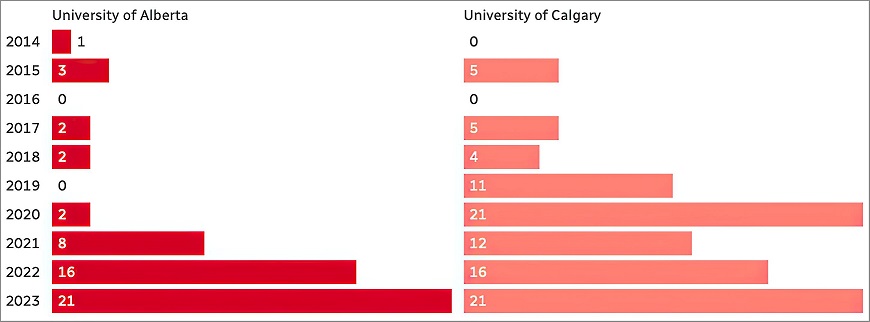Number of Unfilled Medical Residencies Increases in Alberta and Other Areas of Canada
Family medicine academic departments in Canada are dealing with a shortage of applicants qualified for their residency programs, mirroring the shortage of pathologists
For the past decade, the number of medical residencies in Alberta Canada that went unfilled have increased each year. Now, just like in many parts of America, the province is experiencing severe medical staffing shortages that includes clinical laboratories and pathology groups.
According to data compiled by the Canadian Resident Matching Service (CaRMS), after the first round of matching for post-graduate training spots as many as 12% of all spots went unfilled, especially in family medicine, the Canadian Broadcasting Corporation (CBC) reported.
Though the trend seems to be worse in Alberta, the resident shortage is affecting the entire Canadian healthcare system. According to the Angus Reid Institute, approximately half of all Canadians cannot find a doctor or get a timely appointment with their current doctor.
That is fueling predictions of an increased physician shortage in coming years, particularly in Alberta.

Internationally Trained versus Home-grown Doctors
Canada’s current doctor shortage appears to be rooted in red tape that determines which MDs qualify for residency matching. According to John Paul Tasker, a senior journalist at the CBC, “there’s no shortage of doctors in Canada. What we have is a shortage of licensed doctors.” In his article, “Canada Is Short of Doctors—and It’s Turning Away Hundreds of Its Own Physicians Each Year,” Tasker notes that there may be as many as 13,000 medical doctors in Canada who are not currently practicing.
What’s standing in the way of Canadian doctors becoming licensed to practice? Some claim the system of residency matching is discriminatory towards Canadian doctors who received their training outside of Canada. Rosemary Pawliuk, President of the Society for Canadians Studying Medicine Abroad, is one of those who believe the system of matching is broken.
“They have cute slogans like, ‘You’re wanted and welcome in Canada,’ but when you look at the barriers, it’s very clear that you should not come home. Their message is essentially, ‘Go away’ and so [doctors] do,” Pawliuk told the CBC.
According the Pawliuk, “the current residency selection system puts internationally trained Canadian doctors at a serious disadvantage,” the CBC reported. “The Canadian public should be entitled to the best qualified Canadian applicant. Whether they’ve graduated from a Canadian school or an international school, whether they’re a Canadian by birth or if they’re an immigrant, they should be competing on individual merit,” she added.
Canada’s Medical School Matching Bias
In Canada’s current matching system, medical schools decide who gets a residency. Critics say the schools are biased towards Canadian-educated doctors and overlook foreign-trained doctors. About 90% of all residencies in Canada are set aside for Canadian-trained doctors and the remaining spots are left for the physicians trained abroad, CBC noted.
It is important to note that these doctors who are trained abroad are either Canadian citizens or permanent residents. Thus, it’s not a question of citizens from other countries competing with Canadian citizens.
So, if a surplus of doctors are being shut out of residency training opportunities, why are there open slots in Alberta? Some believe this indicates individuals are not interested in practicing medicine in Alberta.
“People aren’t interested in staying or coming to Alberta,” family physician and Alberta Medical Association (AMA) President, Fredrykka Rinaldi, MD, told CBC.
But, Nathan Rider, MD, President of the Professional Association of the Resident Physicians of Alberta (PARA), claims he has not heard of residents turning down Alberta. He notes that the factors of where a resident may want to go geographically often depend on factors such as proximity to loved ones, cost of living, and program culture.
Second Round Residency Matching Fairs Better
Not all are concerned about the vacancies in the first round of matching, however. University of Calgary Dean of Medicine, Todd Anderson, MD, and the University of Alberta Dean of Medicine and Dentistry Brenda Hemmelgarn, MD, PhD, both see the second round as more important.
But Rinaldi still has concerns, “We may fill them with 42 disinterested people who have no interest in family medicine,” she says.
Anderson admits that “Across the country, over the last five or more years, family medicine has become less popular with medical students graduating from medical schools than it was in the years before.”
Therefore, both Anderson’s and Hemmelgarn’s schools have changed curriculum to put more of an emphasis on family medicine. Perhaps with these changes, and possibly an opening for internationally-trained Canadian doctors to achieve residency positions, Alberta’s—indeed all of Canada’s—residency match days will be better attended.
In the United States, there is little news coverage about serious problems with the health systems in other nations. The experience of residency programs in Canada, as explained above, demonstrates how a different national health system has unique issues that are not identical to issues in the US healthcare system. What is true is that Canada is dealing with a similar shortage of skilled medical technologists (MTs) and clinical laboratory scientists (CLSs), just like here in the United States.
—Ashley Croce
Related Information:
Alberta Doctors Sound Alarm Over Low Number of Grads Seeking Residency in Province
Canada is Short of Doctors—and It’s Turning Away Hundreds of Its Own Physicians Each Year
B.C. Fights to Maintain the Barriers That Keep Foreign-Trained Doctors from Working
Can’t Find a Family Doctor in Alberta? Training More Medical Students Is Not the Silver Bullet
US Hospitals Continue to Be Squeezed by Shortage of Nurses, Rising Salaries



